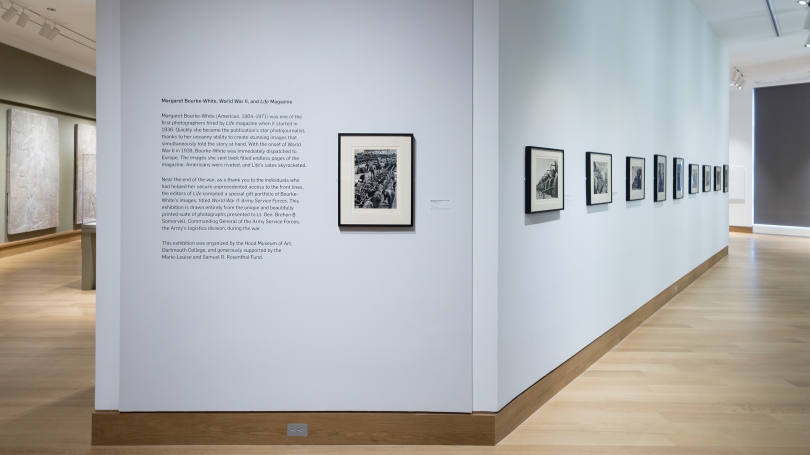JOHN R. STOMBERG, Virginia Rice Kelsey 1961s Director
Hood Quarterly, spring 2023
This year, the Hood Museum will present two separate exhibitions featuring images by the renowned photographer Margaret Bourke-White. Both shows focus on long-term projects for which Bourke-White and her editors organized images in the manner of photo-essays but created portfolios of prints rather than bound books. For projects such as these, we have to consider the deeper context of the whole group of images as though they were printed documentaries; the format, the captions, and the nature of the publishing entity all coming to bear on their possible meanings. In this way, we gain a more complete understanding of the story by consulting more images and through knowing for whom she was "officially" working.
We should consider too the museum and how it is an alternative presenting agency (as compared to sitting with a book or portfolio of prints in your home, for example), one with its own reasons for exhibiting these photographs. This year the Hood Museum is examining the many ways that effective images shape our shared understandings of historical events. To this end, our exhibitions of Bourke-White photographs explore the ways that photographers in the twentieth century have shouldered ever-greater responsibility for visualizing current events and, thereby, have given us the images that defined the times.
On View Through June 24, 2023
Margaret Bourke-White, World War II, and Life Magazine
Margaret Bourke-White (1904–1971) was one of the first photographers hired by Henry Luce as he prepared for the 1936 launch of his new publication, Life. Thanks to her uncanny ability to create stunning images that simultaneously told the story at hand, she quickly became the magazine's star photojournalist. With the onset of World War II, in 1939, Bourke-White was immediately dispatched to Europe. The images she sent back filled endless pages of the magazine. Americans were riveted, and Life's sales skyrocketed.
Near the end of the war, as a thank-you to the individuals who had helped her secure unprecedented access to the front lines, the editors of Life compiled a special gift portfolio of Bourke-White's World War II images, titled World War II: Army Service Forces. This exhibition is drawn entirely from the unique and beautifully printed suite of photographs presented to Lt. Gen. Brehon B. Somervell, Commanding General of the Army Service Forces, the army's logistics division, during the war.
The logistics of war were at the heart of this set of photographs as that was the area of this general's expertise. Over the span of over three dozen images, the Life editors were able to relay the story with pictures while also embracing the theme that US power, and by extension, ultimately the victory in Europe, was based on their vast abundance of resources (human and material). Bourke-White's photograph here depicts soldiers aboard an LST, or Landing Ship Tank, that is loaded and ready to head to Italy from Tunisia. With the repeating forms of the ships' prows, and the sea of soldiers, she conveys both the prowess of the army and the coordination it took to have these ships in North Africa, filled with equipment and soldiers, take off for battle. In this case, the image was part of a larger documentary project, getting at the bigger picture of how the US turned the tide in World War II.
On View July 1–October 1, 2023
"The Land of Tantalizing Mystery:" Margaret Bourke-White in the USSR, 1930–32
After three consecutive trips to the Soviet Union between 1930 and 1932 while working for Fortune magazine, Bourke-White had developed a significant cache of images ranging from portraits of Joseph Stalin's family to her signature celebrations of industry. Many of these were published in the magazine, but also in a book she authored called Eyes on Russia (1931). The twelve photogravures featured in this exhibition are part of the special portfolio she published in 1934 with Argus press based on her—by then—famous Russia photography.
Bourke-White often managed to garner attention for herself as much as for her work. Her Russia portfolio was no exception primarily because she was the first outside photojournalist allowed into the country during Russia's first Five Year Plan (1928–32). She produced images of factories and other infrastructure projects that had been kept secret until this time. To get these pictures, she convinced a long series of Soviet bureaucrats of the advantage to the fledgling nation of having international recognition for their achievements, which she promised to provide through her photographs.
Before she entered Russia for the first time, she had heard about the great privations the people were enduring and she traveled with a trunk of canned food. Everywhere she went, the construction was awe inspiring, but the plight of the workers was hard to ignore. In 1930, she described the situation cryptically: "Little food; No shoes; Terrible inefficiency; Steady progress; Great hope." On her subsequent visits, she moved beyond the machine-age subjects that had until then defined her career and began to focus more on Russian people's lives. This range of interests is witnessed in this exhibition of photographs of the country she described as "the land of tantalizing mystery."
